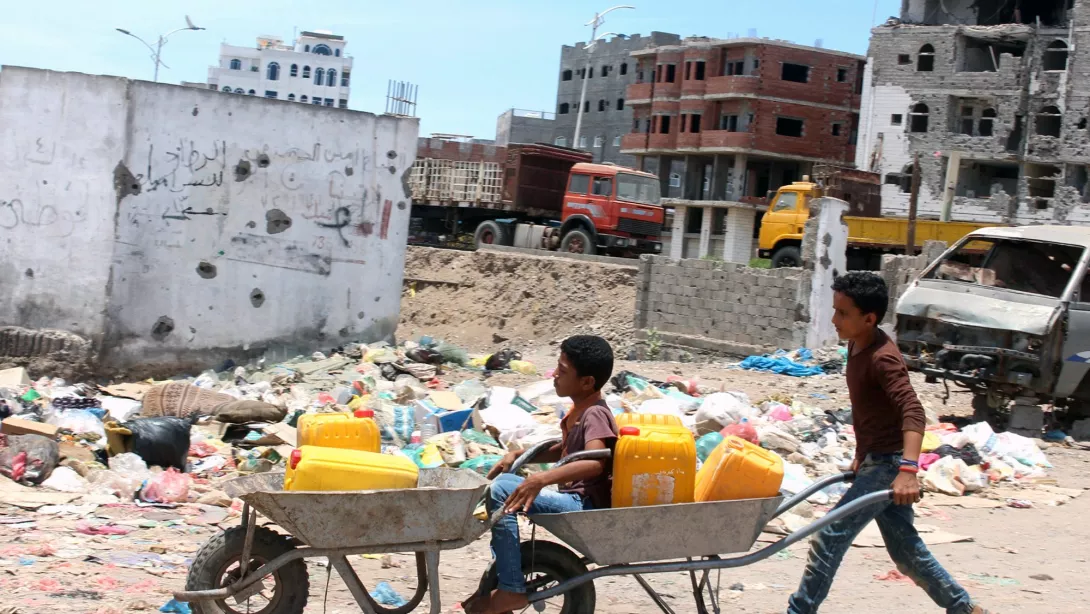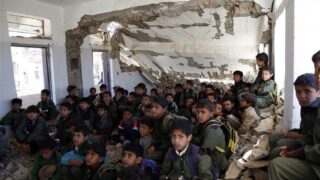This publication file is in the framework of the activities of the network of independant media on the Arab world. The regional cooperation is made by Al-Jumhuriya, Assafir Al Arabi, Mada Masr, Maghreb Emergent, Mashallah News, Nawaat, 7iber and Orient XXI.
Yemen, quite aside from its six-year-old disastrous war, suffers a major water crisis, which will impact its people’s ability to survive in the country long after the military conflict ends. Yemen’s current renewable annual water availability of 72 m3 is way below the 500 m3 absolute scarcity borderline of the internationally recognised Falkenmark indicator, let alone the far higher stress marker of the FAO. As its population continues to increase at a rate close to 3% per annum, per capita water availability drops further each year, given that water resources are also negatively impacted by the process of climate change. While the objective situation is dire, the neo-liberal policies of the Saleh regime (1978–2011) and the international development financiers have contributed to worsening it and increasing inequality.
This article focuses on rural water usage, and in particular the role of agricultural policies in worsening water scarcity in the country. Alongside many other countries, Yemenis use 90% of the country’s water in agriculture. The vast majority, about 70%, of Yemen’s population live in rural areas and more than half of its current total population of 30 million, derive a substantial part of their income from agriculturally related activities, including livestock herding and crop production. Supply of water for domestic purposes is not covered here, as it is subject to numerous and complex different extraction and distribution mechanisms managed with a wide range of techniques, based both on the source and nature of the supply and on local social and political characteristics. These include individual ownership and community management strategies in rural areas as well as larger urban administratively centralised systems in the cities.
Three main factors explain the country’s water scarcity, all directly or indirectly the result of human action: first rapid population growth has increased demand thus reducing per capita water and land availability over generations to well—below self-sufficiency levels. Second, climate change is manifested through increasingly violent and irregular downpours and other phenomena which reduce water availability, particularly by limiting the replenishment of aquifers, as the loss of topsoil prevents absorption of flows, particularly where terraces have deteriorated due to lack of maintenance. Third, the explicit policy decisions of all regimes in recent decades to support diesel-operated pumps and tube well drilling technology for irrigation enabled extraction of water significantly above recharge levels. This has led to the expansion of cropped areas and thus further depletion of the aquifers.
VILLAGES ABANDONED FOR LACK OF RESOURCES
The extent of water scarcity is not the same throughout the country: unfortunately, those areas with the highest population densities are also those with the least available groundwater, whether from renewable or fossil aquifers. In some of the most populated areas, for example the Sana’a and Saada basins, groundwater tables have dropped severely. In some areas, villages have already been abandoned due to the complete depletion of their water tables.
Should all Yemeni water be devoted to domestic usage, per capita availability would be about 200 L/day, significantly more than is needed or used in Europe (about 150 L/day). While it is both technically impossible and unrealistic to suggest such a fundamental redistribution of water usage and population, there is little doubt that Yemen’s water scarcity problem has been exacerbated over recent decades through management policies which have, at best, ignored the fundamental principle of giving priority to direct human needs.
SIGNIFICANT GROWTH IN IRRIGATED AREAS
In the decade before the full-scale war, Yemen was using annually one third more water than its renewable supply, 3.5 billion cubic metres (bcm) while renewable supply was 2.1 bcm, the 1.4 bcm shortfall met by water pumped with modern technology from non-renewable fossil aquifers. [1] These figures cover all water uses. Although, obviously, rain-fed agriculture and spate irrigation also use water, the main change leading to severe scarcity came with the introduction of pump irrigation in the 20th century.
In the past three decades, thanks to pumping, both shallow and deep well irrigation have contributed to the water crisis. The increase in well-irrigated surfaces has been impressive, from 37,000 ha in the 1970s to more than 400,000 ha in the 2000s. During the same period, as irrigated areas increased by a factor of 15, rain-fed agriculture declined by 30% in a country where only about 3% of the land is suitable for agriculture, including broadly defined pasture. According to the only agricultural census held, in 2002, 25% of the 1.6 million ha of agricultural land was irrigated by wells, though the data make no distinction between shallow and deep wells. This has taken place at the expense of the sustainability of the aquifers and also intensified social inequality, helping to explain both the worsening water and political crises. Shortage of water has increased conflicts between communities, particularly between upstream and downstream ones where the former’s increased use has deprived the latter. As shallow wells dry up due to deep well extraction by wealthier neighbours, smallholders are impoverished and eventually forced to sell their lands.
Land distribution is extremely skewed: of Yemen’s 1.2 million landholders, 58% owned a total of 8% of cultivable land in holdings of less than 0.5 ha, while a mere 7% of owners controlled 56% of the land in holdings of more than 5 ha. The main impact on overall water availability is from deep wells, reaching into non-renewable fossil aquifers, and mostly operated by the few larger landowners cultivating high value crops such as qat, mangoes and bananas, the latter two mainly for export. Surfaces devoted to these crops have, in the past three decades, expanded enormously at the expense of staple crops and pastureland, using deep well irrigation. This has been encouraged ignoring sustainability, both with respect to general environmental issues and to basic access to water for domestic uses for the population.
LANDOWNERS AND POLITICAL SUPPORTERS
While the strategy of the international financial institutions (IFI) financing development investments was to promote the private sector at the expense of the public one, Saleh’s focused on strengthening his political support base among influential rural leaders. His regime did not deliberately promote neoliberal economic policies as such, but his political objectives in practice had a similar impact. To guarantee electoral support from powerful and influential rural leaders, he supported policies which increased their wealth thus strengthening their position; most of them were large landowner’s dependent on income from their high value crops, whether qat for internal consumption or exports fruit crops. Some of their income was needed to ensure support from their tribal or other “constituencies.” Saleh relied on them to deliver the votes and support of the population in their areas. Success of Saleh’s political organisation, the General People’s Congress (GPC) was important to maintain the façade of democracy both for internal and international public opinion, as political opposition from various parties was real and significant. Yemeni democracy was not the sham it was in some other countries: the opposition was real and could well have won elections without well-managed manipulation of elections.
Thus, there was complete harmony between the policies promoted by the Saleh regime and those of the Bretton Woods’s institutions to facilitate larger landholders’ plans to increase high value export crops. In Yemen, this automatically meant deep well irrigation as the only reliable regular source of water. Rain fed irrigation was neglected both with respect to financing and agricultural research, despite its suitability for staple grain crops which contribute towards national food security, mainly sorghum and maize and, to a lesser extent, wheat, which, except in the Thame and wadi Hadhramaut, is mainly grown by the thousands of poor smallholders.
Thus, state policies, supported by the major Bretton Woods IFIs, encouraged the development of well-irrigated agriculture by providing both cheap credit for irrigation infrastructure and subsidies for diesel [used for most pumps at that time]. These contributed to the enrichment of landowners who had easy access to loans thanks to their close relationship with the Saleh regime. A major side effect of these policies was increased social differentiation in rural areas, with smallholders finding their shallow wells empty and therefore losing the supplementary irrigation they needed; this reduced their yields, made them poorer and more dependent on other activities for survival, and often led to them having to sell their land, creating a vicious cycle of impoverishment.
It is worth noting that the Cooperative and Agriculture Credit Bank (CACB) was the main supplier of these loans. Its management was a major challenge for the same international financiers as it made little effort to collect debts, resulting in distinctly unhealthy balance sheets. In addition, it was not carrying out its prime official responsibility of helping smaller farmers grouped into cooperatives, while asking for additional international financing. A number of half-hearted international efforts to reform its procedures were an ongoing theme during the first two decades of the Republic of Yemen. (established in 1990 by the unification of the two Yemeni states).
SOLAR ENERGY FOR IRRIGATION
With respect to water management, the situation has not changed significantly in the decade since the Saleh regime ended. During the 2012–2014 transition period, the priorities of all politicians focused on retaining and extending their power, neglecting development and long-term issues such as agriculture or water scarcity, let alone the immediate needs of the majority of the population. International development assistance effectively stopped due to the disagreements between the Yemeni government and the funding institutions over the management of the USD 7.9 billion pledged in September 2012, which never translated into operating projects on the ground.
Covid-19 in Yemen: A Weaponless Battle
08-06-2021
Household funded solar energy for domestic electricity expanded dramatically during the decade in both urban and rural areas due to the absence of network supplies, and this rapidly extended to water extraction, initially for domestic purposes. Since the war started in 2015, solar power for irrigation has also taken off in a big way (Aklan and Lackner 2021, forthcoming), thus offsetting any potential protection of the aquifers which might have resulted from the shortage of fuel for diesel operated pumps, as regular fuel crises are a major feature of the war economy. Given the high investment costs involved in accessing the deep aquifers, solar water pumping is effectively only an option for very wealthy landowners, it is therefore likely to contribute to further depletion of the aquifers. While the war period has witnessed a slight change in the identity of individual beneficiaries of a war economy distorted by the absence of any rules and regulations, overall mechanisms remain unchanged for accumulation of wealth by the few.
ESTABLISHING SUSTAINABLE WATER MANAGEMENT
The importance of introducing and forcefully implementing sustainable water management policies cannot be overestimated and should be taken into consideration not only by Yemenis, but also by the leaders of neighbouring countries as well as the broader international community involved in funding Yemen. If significant areas of Yemen become uninhabitable due to lack of water, their people will first emigrate to the parts of Yemen where there is water, thus increasing political tensions and the potential for conflict in those areas. Eventually they will move beyond Yemen’s borders and suffer forced migration: a rapid look at the map shows that their destinations are likely to be other peninsula states, rather than the Horn of Africa or elsewhere.
The war will eventually end. Although it would be best for Yemen and Yemenis if sustainable water management policies were introduced immediately, this is unlikely to happen while leaders are preoccupied with power, fighting and illegitimate enrichment. However, even now, at the community level, there are areas where improved water management policies could be introduced provided small or larger water basins are under the authority of a single entity concerned with people’s living conditions. Development funders should assist such initiatives, thus laying the foundations for an improved future.
In order to establish sustainable water management in Yemen, its leaders and population must adopt strategies far removed from those of the past, primarily abandon the neoliberal approach and replace it by mechanisms which give priority to the entire population’s need for potable and domestic water, followed by the needs of livestock. Where there is enough water left over after these needs have been satisfied, supplementary irrigation can be used for high-value crops, and here again a new approach, prioritising the smaller landholders, rather than the wealthier ones, should be implemented. Research and extension for high value cash crops, and high-yielding and drought-resistant staple crops should be priorities both for government and international financiers, thus helping Yemeni’s cope with the increasingly challenging climate change situation, let alone its increased population density.
*HELEN LACKNER: An independent researcher, she has worked and lived in Yemen for over fifteen years, five of them in the RDPY between 1977 and 1982. She has just published Yemen in Crisis, Autocracy, Neo-Liberalism and the Disintegration of a State (Saqi, 2017).
_____________________________________
[1]World Bank, Future Impact of Climate Change Visible Now in Yemen, 24 November 2014.





